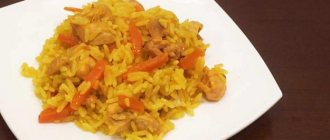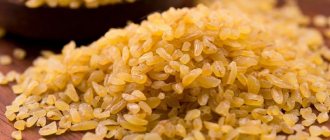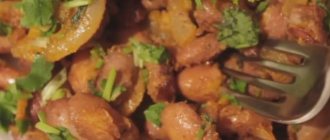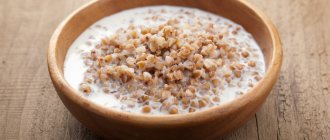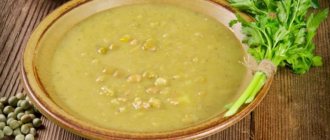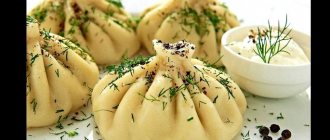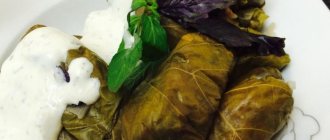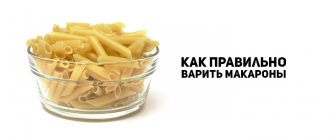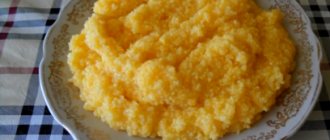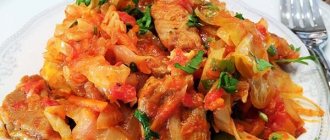How to cook bulgur as a side dish: methods and rules
The mysterious name of the cereal misleads inexperienced housewives. Bulgur is durum wheat, processed in a special way: it is boiled until soft, dried in the sun, then crushed and sifted, dividing into fractions. Then large grains are used for pilaf, small grains are used for minced meat. The harder the wheat variety, the higher the quality of the cereal, the more distinct the nutty notes and the brighter the golden color.
It doesn't take much time to cook. The ratio of cereal and water is 1:2. These are the basic wisdom, the rest depends on the dish.
In a saucepan
Ordinary porridge is an incredibly tasty side dish, a healthy, nutritious and quick breakfast: 2 glasses of cold water, one glass of cereal - in a saucepan, simmer under the lid until the water is completely absorbed.
2-3 minutes before it’s ready, pour in the melted butter and add a pinch of salt, and let it brew a little. This porridge is a masterpiece even without any additions.
In a thermos
You can cook cereal even faster by slightly changing the technology: salted butter, boiling water and cereal in a thermos overnight, and enjoy a delicious breakfast in the morning.
In a slow cooker
The “smart pan” was invented in the image and likeness of a Russian oven, and any porridge in it is delicious. The main thing is not to spoil it with oil.
So, the principle of preparing all cereals in a slow cooker is as old as the world: fill the bowl with ingredients, set the mode and wait for the signal to take a large spoon.
Spelled
Remember Pushkin's fairy tale about the priest and his worker Balda? A simpleton, but not a fool, Balda asked his employer to feed him boiled spelled. Few people remember this mess now. Spelled was prepared from spelled, a semi-wild variety of wheat. At the end of the 20th century, when people began to be more careful about what they eat, nutritionists returned spelled to its former glory - it is even called the black caviar of cereals.
The fact is that spelled wheat cannot be grown on contaminated lands, and it does not tolerate mineral fertilizers. It does not need to be protected from pests and diseases - the hard shell-armor of the grains copes with this task. So spelled is a real organic product, protected from human intervention by nature itself. It also contains gluten, but with a slightly different composition than regular wheat, so it does not cause weight gain or gluten allergies.
Spelled is a universal grain: you can cook porridge from it, add it to soups and even use it in salads. It goes well with meat, vegetables and seafood.
Porridge recipe
Required:
1 cup spelt, 500 ml yogurt, 0.5 cup water, 500 ml milk, 100 g butter.
Cooking:
Soak the spelled for 4–6 hours (or overnight) in a mixture of yogurt and boiled cold water.
Then rinse in cold water, boil over low heat in milk or a mixture of milk and water until tender (the porridge does not boil, each grain remains intact). We check the readiness by tasting after the liquid has completely boiled away.
Season the porridge with oil and serve.
How to cook delicious bulgur: recipes
But let's return to Turkish cuisine. Bulgur occupies a special place in it. If in neighboring countries professional chefs and housewives more often use rice, then in Turkey wheat grain is the No. 1 ingredient in similar dishes.
I must admit that the familiar pilaf, minced meat and side dishes with steamed wheat grain even win. The secret is probably that in addition to all the valuable vitamins and microelements that a person needs, cereals contain almost 600 times more manganese than the daily requirement, and it is involved in the production of serotonin, the hormone of happiness. No cereal, let alone rice, can compare with special wheat grains.
The Turks apparently know this: “The East is a delicate matter.”
Any Turkish or conventionally Turkish dish that contains a “grain of happiness” is an absolutely winning option and a way to plunge into the atmosphere of sun, warmth, or an oriental fairy tale - even in cold winter conditions, when vacation is still far away.
Be sure to read: Bulgur with vegetables: cooking in a frying pan, slow cooker and oven, how to make a lean salad
Bulgur with vegetables and chicken
Balkan cuisine is also reflected in the menus of small, homely cafes at the crossroads of tourist routes in Turkey. It is no longer entirely clear who was the first to invent an ingeniously simple combination of vegetables, dietary poultry with a neutral taste and steamed crushed wheat with a nutty taste: something similar, but under different names, is found in Bulgarian and Greek cuisine.
Ingredients:
- Blue eggplants – 2 pcs.;
- Bell pepper – 4 pcs.;
- Carrots – 2 pcs.;
- Green hot pepper 1 pc.;
- Onions – 2-3 pcs.;
- Blanched tomatoes, without skin -2 pcs.
- Butter and olive oil – 50 g each;
- Chicken breast or fillet – 500 g;
- Garlic, salt, black pepper - to taste
- Coarse-grained bulgur, for pilaf – 200 g.
Preparation:
- Prepare vegetables: wash, peel, cut into cubes.
- Fry the eggplants in a preheated frying pan, without oil, until golden brown, or bake in the oven. Bake the chopped peppers in the same way.
- Pour vegetable oil into a preheated frying pan, melt the butter in it, and fry the onions and carrots until soft.
- Transfer the vegetables to a saucepan, combining with peppers and eggplants.
- Add chopped tomatoes, simmer for 5 minutes, stirring.
- Add cereal to the vegetables, pour boiling water to cover the mass by 2 cm. Simmer until tender. Add hot water if necessary
- Place diced chicken meat in a frying pan. You can replace the pulp with wings or drumsticks. Fry, seasoning with spices and garlic. The golden brown crust will be given by butter, which should be added at the end of frying.
- Place the side dish on the dish in the center, meat along the edge, around.
- Garnish with fresh herbs and serve hot.
This dish is one of the options: you can use any combination of vegetables, replace the chicken with beef or lamb, but in this case the meat should not be fried, but stewed.
Bulgur with dried fruits
This dish is associated with Christmas, somewhere in a village or Cossack village in the South of Russia - its composition is very reminiscent of Christmas kutya. It's worth trying the Turkish version.
But even more surprising is the combination of hot spices and onions with sweet fruits - in the best Iranian culinary traditions from the times of the Persian kingdom. By the way, in Iran such pilaf is part of a festive feast associated with Muslim rituals.
Ingredients:
- Figs, dried apricots, grapes (or raisins) - 80 g each;
- Walnuts (or any) – 80 g;
- Bulgur for pilaf – 300 g;
- Onions – 2 pcs.;
- Carrots – 1 pc.;
- Butter – 3 tablespoons;
- Ground black pepper and salt
You can supplement or replace the set of dried fruits with dates, figs, dried cherries, and prunes. Experiments are not prohibited.
Preparation:
- Steam dried fruits.
- Cut the onion into cubes and chop the carrots into strips. Melt the butter in a saucepan and simmer the onions and carrots until soft.
- Add the cereal to the vegetables, pour boiling water over it, season with spices and salt, simmer until half cooked, then add dried fruits, mix, cover and simmer until the moisture has completely evaporated and the cereal is ready.
If dried fruits are not pre-steamed, they can be added along with the grain. But you still need to pour boiling water over dried fruits, especially if they were bought in a store or market.
Be sure to read: Bulgur pilaf with chicken: step-by-step instructions, classic recipe, cooking in a frying pan and slow cooker
Cinnamon, cloves, nutmeg, vanilla, and cardamom will perfectly complement the harmony of taste in this dish.
Bulgur with mushrooms
Of all the peoples of the world, no one, except the Eastern Slavs, has so thoroughly mastered the technology of collecting, preparing and culinary using mushrooms. In ancient European civilizations, their properties were studied mainly for the purpose of eliminating hated emperors and other rivals and enemies.
In Rus', with the advent of Christianity, mushrooms became an indispensable Lenten product. Fortunately, forests contributed to gathering.
Tourism marketing turned out to be stronger than religious prejudices that Islam supposedly prohibits eating mushrooms (but there is still no clear interpretation on this matter in the Koran!).
Dishes with mushrooms in Turkish cuisine, in combination with bulgur, are no longer new. It is noteworthy that cereals with mushrooms are essentially pilaf, so meat in the recipe is also appropriate, but too complicated. In Turkey, cooks prefer to cook stewed champignons and serve bulgur as a side dish. Like, “figure it out for yourself how it is.”
Ingredients:
- Fresh champignons 200 g;
- Cream 0.05 ml;
- Onion – 1 large head
- Vegetable oil 50 g;
- Spices to taste
- Bulgur 250 g
Preparation:
- Cut the onion into small cubes and fry until transparent in hot oil.
- Prepare the mushrooms, cut into slices, add to the sauteed onions, simmer until tender. A couple of minutes before the end, pour in warm cream (10%). Season with spices to taste.
- Pour the same amount of boiling water over washed and fried wheat in a dry frying pan. If desired, add butter. Cover the pan with a lid and simmer for 10-15 minutes.
- To serve, place porridge on a round dish and mushrooms on top, in the center.
Bulgur pilaf with meat
Pilaf is an international dish. No matter how much adepts argue about the correct set of ingredients and the technology for its preparation, in the East, throughout Asia, and on other continents, every housewife has her own pilaf. Its basis is cereals and/or beans, whatever you have.
The second part is stew. The rest is at the discretion of the cook, in accordance with his national and religious mentality, taste, and culinary imagination.
Ingredients:
- Lamb shoulder 0.5 kg;
- Bulgur 250 g;
- Sweet onions 2-3 pcs.;
- Sweet pepper 3 pcs.;
- Tomatoes in their own juice (or fresh) 5 pcs.;
- Garlic 1 head;
- Spices: coriander, cumin, black pepper, salt.
If the lamb is lean, then you will need 100 g of fat tail fat.
Preparation:
- Cut the prepared meat into medium-sized cubes.
- Place pieces of fat in a thick-bottomed cauldron, melt, add a washed head of garlic, a whole pepper, and ground spices.
- Add meat and fry until half cooked.
- Add the diced onion, simmer until translucent, and after 3-5 minutes put the diced tomatoes in the cauldron.
- Pour in 0.5 liters of boiling water and simmer the meat until cooked. Pour the cereal into the zirvak, cover with a lid, and simmer over low heat until cooked. If necessary, add boiling water.
- When serving, garnish with chopped fresh herbs.
Bulgur has been used to prepare pilaf for more than 4 thousand years - long before the Turkic nomads formed as a nation, and Turkey acquired its own territory and statehood.
Be sure to read: How to cook bulgur in a slow cooker: simple and tasty recipes, step-by-step instructions, how to cook it as a side dish
To be absolutely precise, cereals were the main food of the ancient Greeks; pilaf was prepared from it in Ancient Persia, India, and the Middle East, and, frankly, the nomads did not grow wheat at all. Therefore, Turkish pilaf made from durum wheat is an improvisation, although quite worthy of attention.
Salad with bulgur "Tabbouleh"
The dish “migrated” to Turkish cuisine from Lebanon, acquired characteristic Turkish notes of taste, and now this rebranding is in demand among Russian tourists in the resorts of Antalya, Kemer, Side, Alanya, Belek, Bodrum and other resort attractions in Turkey.
No matter who is the author of the Tabbouleh salad, it is tasty, healthy, quick and simple.
Ingredients:
- Bulgur 100 g;
- Sun-dried tomatoes 30 g;
- Fresh parsley and mint – 20 g;
- Garlic 1 clove;
- Olive oil 20 ml
Preparation:
- Pour boiling water over the cereal in equal proportions, cover the dish and leave to swell. You can use a thermos or a slow cooker.
- Finely chop the mint and parsley, leaving a few leaves to decorate the dish.
- Cut the tomatoes into cubes and chop the garlic.
- Combine the prepared ingredients with the grain and mix. Season the finished salad with olive oil, add salt and pepper to taste.
An excellent addition to the salad is lemon juice for dressing and fresh zest.
Kysir, or Turkish salad with bulgur
- Cooking time: 20 minutes.
- Quantity: 7-8 servings.
- Kitchen appliances. In this recipe you will have to work with a knife, and that’s all.
Ingredients
- 2.5 cups small bulgur;
- 1 bunch of green onions;
- 1 bunch of parsley;
- 4 pieces of thin green pepper;
- 4 tomatoes;
- 1 bunch of mint;
- 2 lemons;
- 0.5 teaspoons each of black and red pepper;
- 0.5 cups olive oil;
- 1 tbsp. a spoonful of pepper paste;
- 1 glass of water.
Recipe for Turkish salad with bulgur
- Pour boiling water over the bulgur, stir and leave to swell for a while.
- While the bulgur is soaking in moisture, don’t waste time and cut the vegetables: tomatoes into small cubes, all the greens and green peppers quite finely.
- Squeeze the juice of two lemons into a separate bowl, pour in olive oil, add pepper paste, as well as black and red pepper, add salt and mix well.
- Pour the prepared sauce over the bulgur and stir until smooth. Add chopped herbs and tomatoes to the bulgur and stir again. Let the salad sit for 20 minutes and serve.
Video recipe for preparing Turkish salad with bulgur
Cooking exotic dishes often confuses us, but that's okay: watch the video and you will not only learn all the intricacies of preparing kysir, but also learn how to serve it beautifully.
What it is?
Bulgur grain itself is nothing more than crushed wheat, always of durum varieties. It is first cleaned by washing with water, then dried very thoroughly, and then crushed into different fractions.
Different sizes of cereals are used in different dishes , for example, the smallest cereals are used in the preparation of pastries and bakery products. The specific nutty taste and pleasant crunch are acquired thanks to this admixture. Medium grains are used for preparing side dishes and first courses. And the coarsest grind is used in pilaf. The pilaf turns out to be a pleasant golden color.
It’s not at all difficult to prepare this cereal correctly, step by step, at home, if you take into account all our recommendations. It is suitable as a food for weight loss, and pilaf from it, cooked in the microwave, will amaze with its taste.
